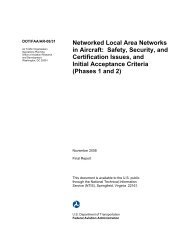Published Report (DOT/FAA/CT-94-36)
Published Report (DOT/FAA/CT-94-36)
Published Report (DOT/FAA/CT-94-36)
Create successful ePaper yourself
Turn your PDF publications into a flip-book with our unique Google optimized e-Paper software.
FDADS SIMULATION AT DENVER<br />
A demonstration simulation of the Full Digital Automated Radar<br />
Terminal Display System (FDADS) was conducted November 16 and 17,<br />
1992. Thirty-six 30° blunders were simulated, of which 12 were<br />
shown by later analysis to be at-risk. Three TCV's were found<br />
among the 12 at-risk blunders, resulting in an observed TCV rate<br />
of 1/4. After two days of simulation, the decision was made by<br />
<strong>FAA</strong> management to discontinue the FDADS simulation in favor of<br />
the FMA. The analysis presented here will support that decision.<br />
The analysis will show that the TCV rate for the FDADS simulation<br />
is significantly larger than the TCV rate for the FMA simulation.<br />
The analysis will also show that the larger TCV rate of the FDADS<br />
simulation could lead to an unacceptably large risk.<br />
Although the sample size is small, some conclusions regarding the<br />
data may be drawn. Since the number of at-risk, worst-case<br />
blunders was much larger for the FMA simulation, the observed<br />
Bernoulli ratio for the FMA simulation may be regarded as much<br />
more accurate than that for the FDADS simulation. The observed<br />
ratio for the FMA simulation was 2 TCV's per 186 at-risk<br />
blunders, or 1/93. Since binomial probabilities are easily<br />
computed, the null hypothesis that the probability of a TCV<br />
during the FDADS simulation is the same as that for FMA, Ho:p =<br />
1/93, may be tested against the alternate hypothesis, H1:p ><br />
1/93, directly from the binomial distribution. A significance<br />
level of 0.05 will used to lessen the likelihood of a type I1<br />
error.<br />
If the probability of a TCV during the FDADS simulation was also<br />
p = 1/93, then the probability P of observing 3 TCV's in a sample<br />
of 12 at-risk blunders would be given by:<br />
r2)(lI(gr<br />
= 0.000248.<br />
P = 3 93<br />
The probability of 3 or more TCVIs in a sample of 12 may also be<br />
computed and is found to be P = 0.000254. Since the probability<br />
of 3 or more TCV's in a sample of 12 is smaller than 0.05, the<br />
alternate hypothesis, that the probability of a TCV using FDADS<br />
is larger than the probability of a TCV using FMA, is accepted as<br />
being true.<br />
If the upper confidence limit for the FMA simulation, 5 TCV's per<br />
102 at-risk blunders, is used for the estimate of the probability<br />
of a TCV given an at-risk blunder, then the null hypothesis would<br />
be Ho:p = 5/102 and the alternate hypothesis would be H1:p ><br />
5/102. The probability of 3 TCVIs in a sample of 12 at-risk<br />
blunders, assuming p = 5/102 is computed as follows:

















